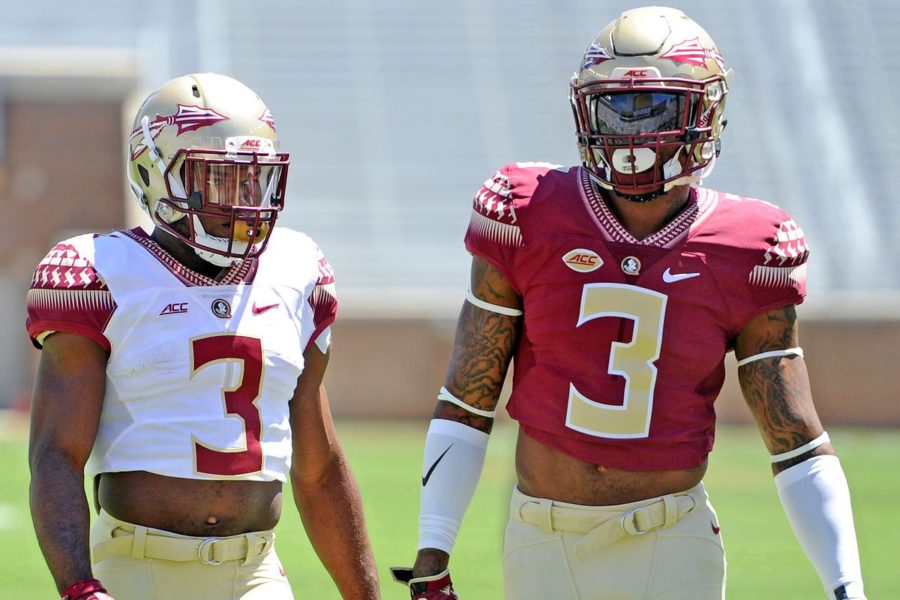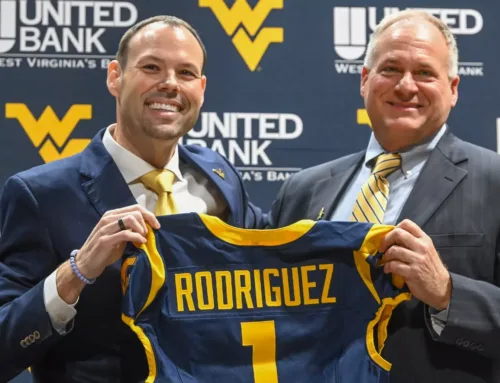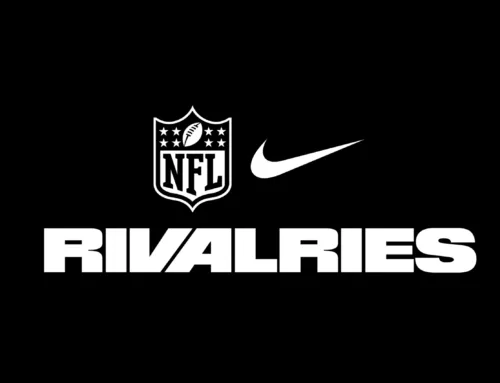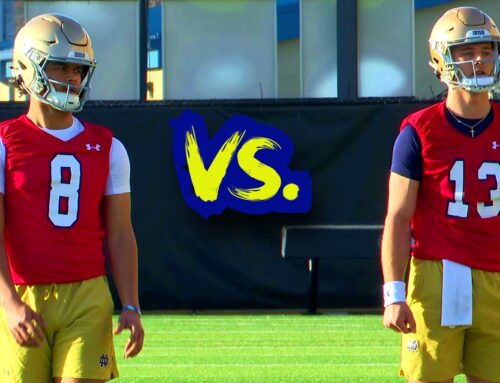In part one of a three-post series, let’s take a look at Notre Dame’s 2018 opponents ranked by their preseason S&P+ ratings. Beginning with the toughest five games on the schedule, what elements are driving these preseason ratings, in a positive or a negative direction, for each team? How does each team look in terms of recruiting, returning production, and five-year track record?
If you’ve been sleeping on it, the long off-season march towards projecting the 2018 season has already begun with the close of the 2018 recruiting class and gradual slowdown of the coaching carousel. Bill Connelly published his early preseason S&P+ rankings recently – and while these will change a bit with injuries and transfers, the pecking order should stay more or less the same until the games start in the fall. Included in these early rankings was a pretty transparent explanation of the components going into the preseason S&P+ formula – recruiting impact, returning production (weighted by both last season’s performance), and 5-year program track records.
Notre Dame’s toughest five opponents all rank between #10-21 in these preseason rankings – no one team looks unbeatable, but there’s a lot of quality spread throughout the beginning, middle, and end of the season. For each program I’ll take a brief look at what S&P+ likes about each team, what is bringing their rating down, and what S&P+ (or in many cases, anyone) doesn’t know yet that could impact their 2018 trajectory and narrative.
Michigan, Projected #10
What S&P+ likes: The defense and recent track record
Despite losing tons of starters and production from 2016’s #2 Defense in S&P+, the Wolverines only fell to #10 in 2017 under Don Brown. That’s a testament to both the quality depth that existed on the 2016 team, the level of recruiting Harbaugh was able to pull off in his first classes in Ann Arbor, and Brown being a beast. Now Michigan returns the 15th highest level of defensive production from a unit that was strong last season, and yeah, unfortunately that’s probably another top-5 defense the Irish will be facing in the opener.
Despite the facts that you know and love from the Harbaugh tenure – that the much-hyped return of the man in Khakis still hasn’t resulted in beating Ohio State or a finish better than third in the Big Ten East – S&P+ still looks favorably on his track record over the past few seasons. Finishing 30th in F+ in Year 3 is certainly not a good look, but the Wolverines were 4th in 2016 despite three losses (all close / two to playoff caliber teams) and 8th in 2015.
What S&P+ doesn’t like: The offense, especially passing game
Michigan finished a dreadful 85th in Offensive S&P+ last season, driven primarily by an 86th place finish in Passing S&P+. It didn’t matter much whether it was Wilton Speight (now transferred), Houston transfer John O’Korn (now graduated), or redshirt freshman Brandon Peters (still there!). The Wolverines threw just 9 touchdown passes all season despite all the QB whispering that their head coach attempted.
The offense returns Peters and a good arsenal of skill position talent, especially at running back, but there’s still turnover on an offensive line that wasn’t good last season. The 2018 recruiting class was also the worst full class of the Harbaugh era, so I wouldn’t expect many instant-impact freshman to make splashes in South Bend in the opener.
What S&P+ doesn’t know: Shea Patterson’s impact (or not) and the insane schedule
The Michigan offense could get a significant jolt if former Ole Miss QB Shea Patterson receives a waiver to gain immediate eligibility. Solid play at that position has been the Achilles heel of these recent UM teams, and while the offensive line will still be shaky, Patterson had lots of practice improvising last year behind a poor line in Oxford last year. There might be enough skill position talent that with the addition of Patterson, the offensive potential goes from poor-mediocre up to mediocre-good.
The fun question for 2018 is also how well Harbaugh year four goes against a brutal schedule. Even with a top 10-20 team there could be 3-4 losses in play, not to mention what happens if the team underachieves. Fan satisfaction with the welcomed hero Harbaugh is at an all-time low after 8-5 and an Outback Bowl implosion. The Wolverines play at preseason S&P+ #1 Ohio State, at #7 Notre Dame, and at #11 Michigan State. At home they get #8 Penn State and #12 Wisconsin. Good luck!
USC, Projected #15
What S&P+ likes: Top recruiting classes, solid recent performance
In 2017 the Trojans were #3 in the 247 Talent Composite, with 8 five-stars and 41 (!) four-stars, trailing only Alabama and Ohio State. They followed that up with a 2018 class that despite having only 18 signees featured 4 more five-stars and 13 more four-stars. USC virtually recruits itself, but Clay Helton and staff are probably a little under-recognized for their work on the recruiting trail.
While the last few seasons have probably fallen short of what USC fans hoped for, S&P+ also likes the recent body of work the Trojans have put together. Despite underachieving relative to the elite talent level and in won-loss record, Southern Cal hasn’t finished worse than 19th in F+ over the past five years.
What S&P+ doesn’t like: Significant roster turnover
With Sam Darnold, Ronald Johnson, and Deontay Burnett leaving early to the NFL, the Trojans rank 123rd in returning offensive production. The defense loses less (64th in returning defensive production), but lose their leading tackler from the secondary (Chris Hawkins), two leading pass rushers (Uchenna Nwosu and Rasheem Green), and run stuffing DT Josh Fatu. The return of Cameron Smith and a healthy Porter Gustin will help, but there are major gaps to fill in the front seven on a defense that only finished 55th in Defensive S&P+ last year.
What S&P+ doesn’t know: Will QB competition cost the Trojans?
Two years ago Helton seemed to mismanage his quarterbacks, starting Max Browne in a disastrous blowout against Alabama and a loss to Stanford where the offense mustered just 10 points. Then Helton turned the keys over to Darnold, who led the Trojans to nine straight (including a Rose Bowl) wins.
This year Helton faces another dilemma, with redshirt sophomore Matt Fink battling redshirt freshman Jack Sears and incoming true freshman JT Daniels. USC wisely opens with UNLV this year instead of the Tide, but still have little room for error with games two and three on the road at Stanford and Texas.
Florida State, Projected #18
What S&P+ likes: Recruiting, and 2017 as an outlier
S&P+ counts on Florida State to bounce back thanks to stellar recruiting classes (#5 nationally) and the 4th best 5-year weighted track record. In the four years prior to 2017’s disaster the Noles were a top-15 team each season. Even though the returning production isn’t great, historical data suggests programs with a track record like FSU’s are expected to bounce back from a poor season and reacts less than conventional wisdom would suggest to one bad season.
The offense lost top receiver Auden Tate, but he wasn’t an overly productive target compared to his immense physical / pro potential. Jacques Patrick and Cam Akers will be two of the best backs in the ACC and Francois and Blackman both have strong experience. The offensive line returns four of five starters – they weren’t good last year, but UGA showed that sometimes blue-chip talent can take a big leap with just another year of continuity. Willie Taggart’s scheme could help too.
What S&P+ doesn’t like: 2017 was brutal, and there’s lots of key departures
The Seminoles season quickly ran off a cliff last season, beginning with the loss of QB Deondre Francois for the season in the opener in Alabama and climaxing with a beatdown at Boston College. The Noles finished 35th in F+, and that was propped up by salvaging a decent second half against bad opponents. FSU returns a lot of pieces from an offense that was 75th in Offensive S&P+ (how good are the pieces?) and loses a lot from a defensive that was 33rd in Defensive S&P+ (but was hyped up as a potential top-5 unit preseason).
The defense returning production rank is 120th, with virtually all of the eligible defenders opting to go pro with the exception of DT Demarcus Christmas. With Derwin James, Josh Sweat, Matthew Thomas, and Derrick Nnadi all going pro the Seminoles lose their top four tacklers. The blue chips are there to replace them, but last season showed that translating that talent into production isn’t a given.
What S&P+ doesn’t know: The Taggart transition may not be seamless
Disclaimer: Willie Taggart is a good coach and solid hire after the weird Jimbo Fisher departure. But his track record is NOT one of instant turnarounds. In his first head coaching job at Western Kentucky, his team was 2-10, an improvement from 0-12 but not an immediate turnaround. His first two years at South Florida he was on the hot seat after a combined 6-18 start. Last season Oregon improved to 7-5 but still finished 50th in F+.
So it may take some time for Taggart to get FSU from their 35th in F+ last season back up to the top-5 or 10 range fans expect (and their recent recruiting has reflected). It would be better for the Irish to face FSU early in the year as young guys are still gaining experience and time in the system, but as a trade-off we get to see a lot of southern natives adjusting to South Bend weather in late November.
Stanford, Projected #20
What S&P+ likes: Consistency from Nerd Nation, Bryce Love
Last five years F+ (moving back in time from 2017): 18th, 25th, 6th, 18th, 3rd. That’s a solid track record, especially with top-10 seasons not all that far in the rearview mirror. The Cardinal also return the 22nd most offensive production, a rank that swung wildly with the return of Bryce Love for his senior season. That move alone probably swung Stanford’s preseason S&P+ ranking a few spots.
Quarterback has also been a point of inconsistency for Stanford in recent years, but KJ Costello seems to be more of the Kevin Hogan mold than failed starters Keller Chryst and Ryan Burns. If Costello does goes south, they do have a nice contingency plan with former top-15 national recruit Davis Mills.
What S&P+ doesn’t like: So-so recruiting, big losses on defense
As Eric pointed out in his rival recruiting review, Shaw and company have not had a great last two classes. The quality was high in the 2017 class, but with just 29 players in the last two classes you have to be concerned with depth. And unlike the year before, the ’18 class doesn’t feature much top tier talent. That causes some concern when paired with a ranking of 110th in returning defensive production.
Those departures don’t spell out good things for a Cardinal defense that was a leaky 59th in Defensive S&P+ last year. It’s hard to imagine the defense improving by enough to compete for the Pac-12 title, and relying on Bryce Love and jump balls to out-explosive opponents seems like the opposite of the traditional Stanford strategy.
What S&P+ doesn’t know: How will the Cardinal respond if there’s early adversity?
The first five weeks for David Shaw – hosting San Diego State (who clipped Stanford last year), welcoming USC, a breather against UC Davis, and then away games at Oregon and Notre Dame. The second half also features four games against top-40 opponents (Washington, Wazzu, Utah, and UCLA). If Bryce Love has to shoulder another incredibly heavy workload for the offense, you have to wonder how much gas this team will have left in the tank by the end of the season.
Virginia Tech, Projected #21
What S&P+ likes: Everything is solid
There’s no huge red flags for the Hokies – their recruiting is good and stable, their returning production is decent, and their recent track record is fine (but lacking a big win). VT has established a recruiting advantage over most of the league, with a gap that’s unlikely to close against the top of the conference in Clemson, FSU, and Miami. There was an outlier poor performance in Frank Beamer’s last year in 2015, but consistency has been a hallmark in Blacksburg. The Hokies have finished between 18 and 33 in F+ four of the past five years.
Justin Fuente returns the 64th most returning production on offense and the 67th most on defense. A lot of starters and depth return, but many of the best players (Cam Phillips, Wyatt Teller, Tremaine Edmunds, Andrew Motuapuaka) have departed due to graduation or the draft.
What S&P+ doesn’t like: Nothing is spectacular
S&P+ sees the Hokies as dangerous but not really a title contender. The ceiling recently for VT has been in the top 10-15 range, with a #20-30 quality team as baseline. The top-line blue chip talent isn’t quite there enough – the Hokies are pulling in a few per class at most – and the returning production is just ok.
The best chance Virginia Tech has at jumping from good to great is through its defense. The Hokies finished 9th in Defensive S&P+ last season and Bud Foster seems to reload each season regardless of new faces. If the defense can be close to as good – the defensive line was very strong in 2017 and returns most intact – the offense should finish better than last year’s 96th in Offensive S&P+.
What S&P+ doesn’t know: Is Josh Jackson going to take a leap to stardom or have a sophomore slump?
Quarterback Josh Jackson had a fairly strong debut in his true freshman season. He averaged a so-so 6.8 YPA but had a 20-9 TD to INT ratio, and chipped in decent rushing production (466 yards and 6 TDs on the ground). He led a decently efficient but not very explosive offense, in part due to a running back / offensive line combo that finished almost dead last in rushing explosiveness in all of FBS.
If Jackson builds on his debut, the offense can be threatening enough to pull some big upsets when combined with the usual solid Hokie defense. He’ll have to do it with an offensive line that probably won’t be much better, a rushing attack that has the same non-explosive backs, and replacing his top receiver. But he’s probably the difference between a possible 10-win season (which is very much in play, especially if they can knock off FSU in the opener) and another mid-level ACC bowl.





I mentioned this on Twitter but will also drop here – I was surprised in writing this that I actually agreed with S&P+ that Michigan is probably the best team on the 2018 schedule. The offense is a huge question mark, but every team has some and big potential flaws (definitely no team looks to be as good as UGA was last year).
But it feels like a lock that UM will have a top-5 defense, and unless everything goes completely to crap on offense again (possible, but maybe improbable, especially if Patterson gets a waiver) then they seem like a safer pick than believing USC will just reload, FSU will bounce back, etc. Stanford could have been that team, but virtually every guy on defense who had a decision about the draft declared early.
FWIW, they’re also the most likely national champion we play by current odds – https://sports.bovada.lv/football/college/futures-market-group
Good stuff Mike, and I love the “What S&P+ doesn’t know” component. Four stars, would order again.
Hate to say it but I’d buy Stanford stock among this group. Though they might lose some shootout-y games in the Pac-12 their offense provides a lot of stability.
I mean, I hate buying Stanford stock, but I hate it less than buying Michigan stock, which I am also doing now. I was at UW when they played UM; UM looked good for a young team and Wisconsin got a couple key calls that made the margin look wider than the quality gap.
Is it too early to hope that Stanford has a tiny class for three years in a row and they have a fifty five man team the year after next? I also like playing them early since they seem to get better as the year goes on.
Also, great article. Thank you.